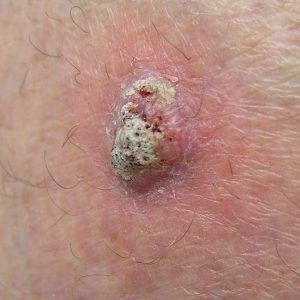SCC
Squamous Cell Carcinoma (SCC) is the second most common skin cancer. SCC accounts for about one-third of non-melanoma skin cancers. It arises from the outer epidermal layer of the skin and mucous membranes and occurs most commonly on areas exposed to the sun. If untreated, SCC may penetrate and destroy underlying tissue. Sometimes, this tumour can spread to distant organs and may become fatal.

- SCC is a skin cancer that happens onon chronically sun exposed part of the body like face, hands, forearms and lower leg.
- SCC presents as sore, scab or scaly patch of skin that doesn’t heal within 2 months.
- Complete removal of SCC is achievable by surgical excision of the cancer.
- Avoiding excessive sun exposure is the most important step to prevent SCC.
What is the cause of SCC?
- Skin complexion and hair colour – People with fair-skin, especially those who do not tan easily, those with lots of freckles, and red or blonde hair
- Personal history –Patient with previous skin cancer have a 35% – 50% probability of getting a new skin cancer within five years
- Family history – family history is associated with an higher risk
- Ethnic group – caucasian people are at higher risk than other ethnic groups
There are also number of non genetic risk factors:
- Chronic sun exposure
- history of burns
- scars
- exposure to radiation or chemicals
- chronic inflammatory conditions
- immunosuppression
- HPV infection
- Men are more likely to develop SCC
- Age: Skin cancer risk increases by ageing

Different shapes of SCC
SCC could present in different shapes and forms: Common presentations are as :
- crusted sores
- small ulcer
- thickened scaly skin on the lip
- sore patch of skin
- firm, red lumps
- red, raised sore around anus or genitals
SCC usually appears on areas of the skin that are most often exposed to the sun, such as the head, neck, hands, forearms or lower leg. It often appears as a thickened, red, scaly lump. SCC may look like a sore that hasn’t healed. SCC can be quite an aggressive cancer if left untreated. If you ever notice a sore, scab or scaly patch of skin that doesn’t heal within 2 months, see a doctor.
Early stages of SCC, which is called IEC (intra epidermal carcinoma) or Bowen’s disease, appears as red, scaly patch, can also progress into SCC if not treated.
SCCs tend to grow quickly over several weeks or months. It is possible for SCCs to spread to other parts of the body – SCC on the lips, ears, scalp or temples has a high risk of spreading and should be seen by a doctor immediately.
Time to see your doctor
Skin cancers incuding SCCs are treatable if detected early. If you have any of the following signs, do not hesitate to see your doctor.
- a sore that doesn’t heal in 2 months
- a new or unusual looking spot
- changes in existing spots; Any change\ in colour, size or shape is important.
- Asymmetrical (irregular and not round or oval) skin lesions
- Skin lesion with irregular edges
- Skin lesion with unusual or uneven colour
- Any spots over 6mm diameter

How is SCC treated?
Simple skin surgery (excision) is the most effective treatment of SCC. After the excision, specimen is sent to the pathology lab and examined under microscope to ensure SCC has been completely removed. If there was any residual SCC, or nerves were involved, further excision and / or radiation therapy might be indicated.
Recently an immunotherapy drug (Cemiplimab) has been approved in Australia for use by oncologists for metastatic or locally aggressive SCC.
Sometimes, small SCCs on torso are treated by a scraping and diathermy called curettage or by freezing with liquid nitrogen These options are less effective than excision and there is a higher risk of recurrence.
Radiation therapy has also been successfully used to treat SCCs with over 98% success rate. Regular follow up will be required to check and monitor for any signs of recurrence
How to prevent SCC?
The best way to prevent SCC is to avoid sunburn. Check BOM and if UV Index is higher than 3, stay away from the sunlight. Seek shade, wear a hat, sunglasses and clothing that protects you from the sun, and always use an SPF50+sunscreen.
Vitamin B3 tablets (niacinamide) is proven to be helpful in reducing skin cancer risk. Talk to your doctor about vit B3 and skin cancer risk reduction according to your individual needs.


